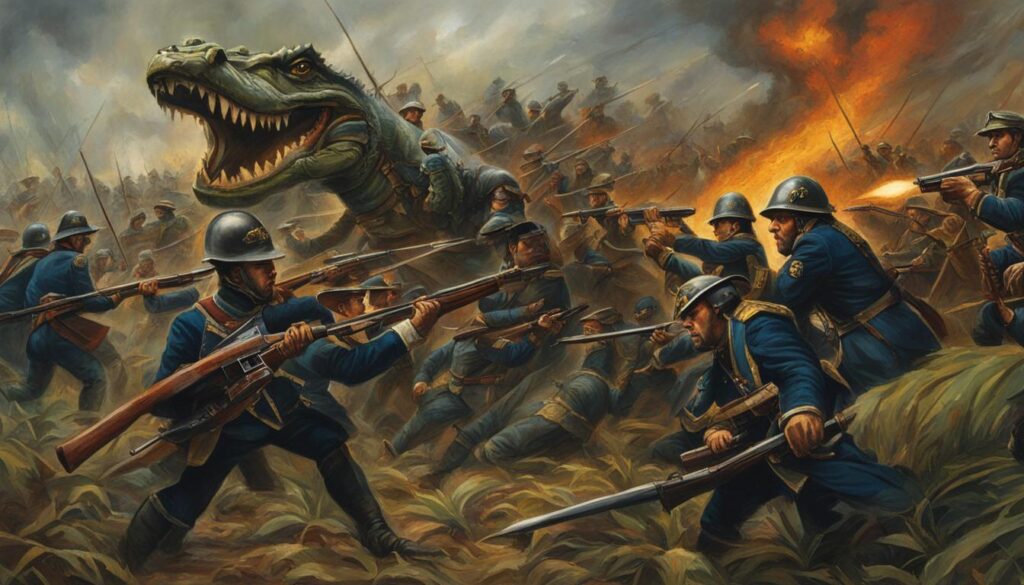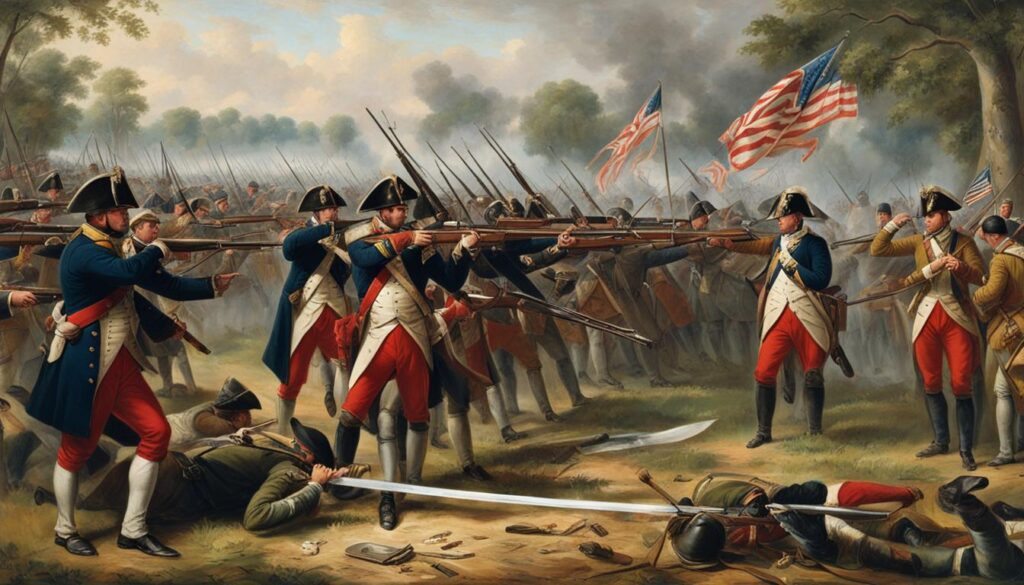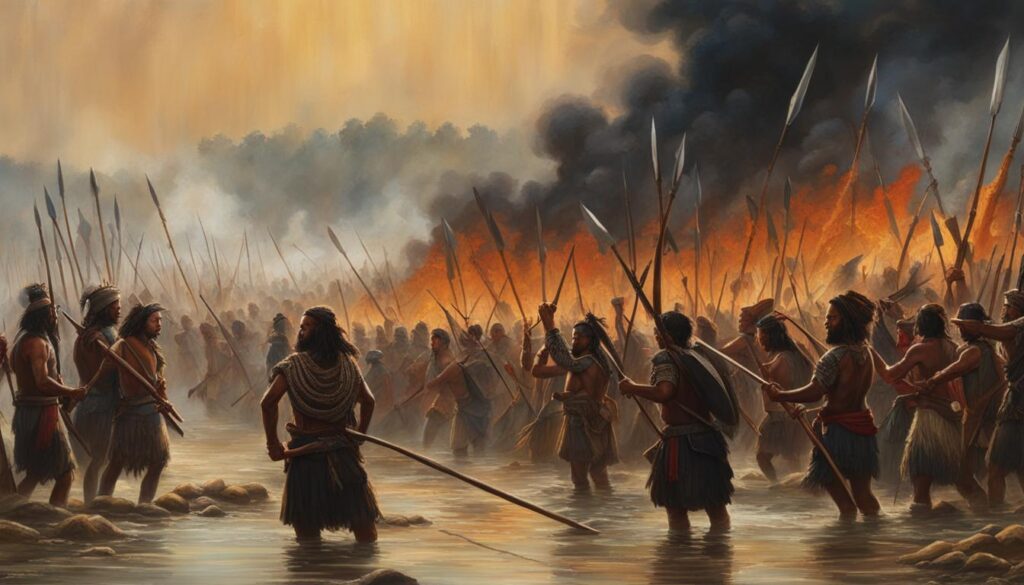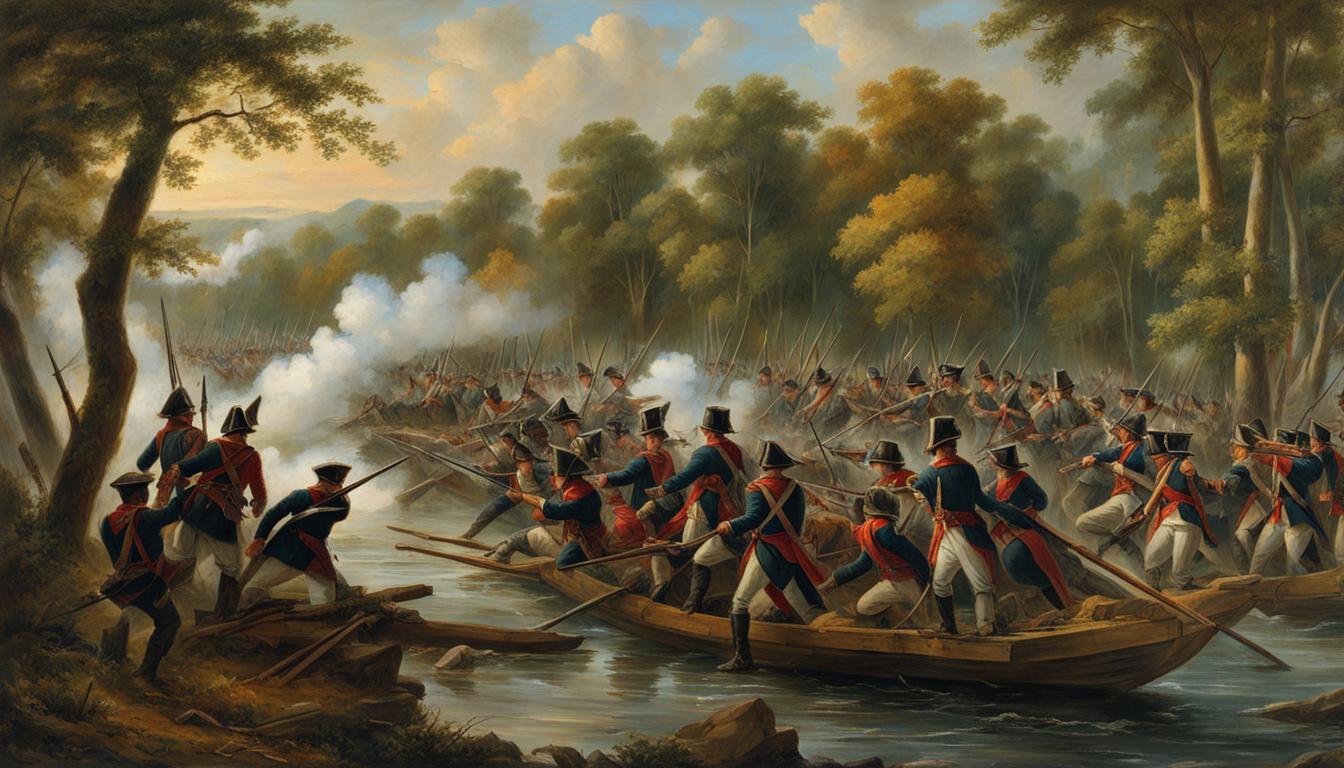The Battle of Alligator Bridge, which unfolded on June 30, 1778, is an event that holds great significance in the history of the American Revolutionary War. The confrontation marked the only major engagement during an unsuccessful campaign to capture British-controlled East Florida. Georgia militiamen under the command of General James Screven clashed with British forces led by Major Mark Prevost and Loyalist troops commanded by Thomas Brown. The ensuing British victory played a crucial role in sustaining British control over the region, shaping the trajectory of the American struggle for independence.
Key Takeaways
- The Battle of Alligator Bridge occurred on June 30, 1778, as part of the American Revolutionary War.
- Commanders in the battle included General James Screven, Major Mark Prevost, and Thomas Brown.
- This engagement was focused on seizing British-controlled East Florida.
- The British victory helped maintain control over the region, impacting the American struggle for independence.
- Understanding the battle provides valuable insights into the complexities of the Revolutionary War.
The Historical Context of the Battle of Alligator Bridge
The Battle of Alligator Bridge was a key event in the Southern theater of the American Revolutionary War. It took place amid a series of skirmishes and raids along the frontier separating Georgia and British-held East Florida. The strategic significance of East Florida, particularly its capital of St. Augustine, led political and military leaders in Georgia to repeatedly plan expeditions to capture the territory. However, these efforts faced numerous challenges, including unsuccessful attacks and logistical failures.
- 1776: Collapse of an expedition to invade East Florida
- 1777: Ambush at the Battle of Thomas Creek
- 1778: Loss of military posts south of the Satilla River and Loyalist raiding activities along the frontier
These setbacks prompted Georgia’s leaders to believe that an invasion from East Florida was imminent, ultimately leading to the organization of a third expedition against the territory.
“The Battle of Alligator Bridge constituted a crucial episode in the context of the ongoing struggle between Patriot forces and Loyalist militias in the Southern theater of the American Revolutionary War.”
| Year | Events |
|---|---|
| 1776 | First exploratory expedition into East Florida was unsuccessful |
| 1777 | American forces ambushed at the Battle of Thomas Creek |
| 1778 | Battle of Alligator Bridge: American forces defeated by a combined British-Loyalist force |
In summation, the Battle of Alligator Bridge was part of a broader engagement between Georgia and East Florida raiding activities during the American Revolutionary War. The battle served as a significant milestone in the ongoing hostilities within the Southern theater and shaped the future course of the conflict.
Unveiling the Battlefield: The Geography of Alligator Bridge
The battlefield at Alligator Bridge is believed to be near present-day Callahan, Florida, and was the setting for the June 30, 1778 engagement. This historical site holds great significance in the Revolutionary War history, with a crucial engagement taking place amidst the unique geographical features.

The locale featured a key bridge across Alligator Creek, a tributary of the Nassau River. This strategic point was utilized by Major Mark Prevost to set up a fortified defensive log and brush redoubt for the British forces, which played a significant role in the battle’s outcome. The natural geography of the battlefield location provided an advantageous defensive position for the British troops.
“The bridge across Alligator Creek proved to be an essential strategic asset, enabling the British forces to effectively secure their position and stifle the advancement of the American militia.”
Understanding the overall battle location and geography is crucial to comprehending the tactical decisions deployed during the Battle of Alligator Bridge. Here is a brief overview of the key geographical features of the site:
- Location: Near present-day Callahan, Florida
- Alligator Creek: Tributary of the Nassau River
- Nassau River: Flows from West to East through Nassau County
These geographical aspects facilitated the progress and outcome of the Battle of Alligator Bridge, ultimately shaping the trajectory of events and their historical implications.
Leading Figures: The Commanders of the Battle
The Battle of Alligator Bridge was shaped by the actions and decisions of the commanders on both sides of the conflict. Their strategic choices and individual contributions determined the outcome and demonstrated the complexities of the American Revolutionary War.

General James Screven and His Role
As one of the American Revolutionary leaders, General James Screven’s contribution played a pivotal role in the Battle of Alligator Bridge. He led a detachment of Georgia militiamen in pursuit of Thomas Brown’s Loyalist company to intercept them at the bridge. Engaging the British and Loyalist forces in a firefight, Screven’s men initially created confusion among the enemy ranks. However, the British quickly reorganized and counterattacked. Screven was wounded in the confrontation; his command ensured that the Continental militia narrowly avoided a full encirclement before ordering a retreat.
Major Mark Prevost’s Tactical Decisions
Major Mark Prevost, a notable Revolutionary War British commander, took charge of the British forces defending against the American offensive at Alligator Bridge. He deployed detachments of the 16th and 60th Regiments and directed them to construct defensive fortifications. Prevost’s British military strategy, which involved establishing a redoubt and utilizing the natural geography to their advantage, proved crucial to the British victory. The pursuing American militia were caught off-guard, allowing Prevost’s troops to successfully defend their position and achieve victory.
Thomas Brown and the Loyalist Militia
Thomas Brown, an influential figure among American Revolution Loyalist commanders, led a regiment of rangers and Loyalist militia in performing raids across the frontier. Brown’s impact on the Battle of Alligator Bridge was felt through his intelligence and maneuvers, which sowed confusion among the Patriot forces after the burning of Fort Tonyn. When his Loyalist company was engaged by the Georgia militiamen, they initially retreated but then headed straight for the British defensive positions prepared at Alligator Bridge. Brown’s company contributed to both the defense and offense during the battle, showcasing the importance of the Loyalist militia in Revolutionary War campaigns.
Alligator Bridge Battle: Comparative Military Strengths
The Battle of Alligator Bridge, an important engagement in the American Revolutionary War, saw American forces consisting of 100 cavalry and 100 militia facing off against British infantry numbering around 700, plus 100 Loyalist militia. In analyzing the comparative military strengths of both sides, it is evident that the significant disparity in numbers played a pivotal role in the final outcome, with the smaller American force confronted by a composed and heavily fortified British defense.

To provide a clearer understanding of the contrasting forces during the Battle of Alligator Bridge, a summary of the key elements is highlighted in the table below.
| Side | Cavalry | Militia | Infantry |
|---|---|---|---|
| American | 100 | 100 | 0 |
| British and Loyalist | 0 | 100 | 700 |
The American forces, led by General James Screven, were heavily outnumbered and faced a challenging task as they attempted to engage Thomas Brown’s Loyalist company and the British infantry under Major Mark Prevost’s command. Despite their smaller numbers, the American forces applied various tactical approaches in an attempt to overcome the odds and achieve their objectives.
“The smaller American force, consisting of 100 cavalry and 100 militia, demonstrated courage and determination in the face of a far larger, heavily fortified British and Loyalist force.”
In conclusion, a key factor that contributed to the outcome of the Battle of Alligator Bridge was the contrasting military strength of both sides, with the American forces at a significant numerical disadvantage. By analyzing the forces present during this engagement, readers can gain an appreciation for the challenges faced by the American forces and the strategic planning that underpinned the British and Loyalist defense.
The Prelude to Conflict: Events Leading to the Skirmish

Before the Battle of Alligator Bridge unfolded, the American side, commanded by General Robert Howe, assembled a force of about 1,300 men. This group included Georgia militia and South Carolina Continentals, who gathered at the site of Fort Howe. However, the march towards East Florida was slow and plagued by adverse weather conditions and desertions.
On the other hand, British forces, led by Governor Patrick Tonyn and General Augustine Prevost, embarked upon preparations that comprised regular raids into Georgia and strategic deployments along the St. Marys River. These events significantly impacted the prelude to the Alligator Bridge skirmish.
Communication and planning breakdowns between Georgia Governor John Houstoun and General Robert Howe further compounded the difficulties faced by the American forces.
Both the Americans and British were positioning themselves for the coming battle, with each side preparing its troops, strategies, and intelligence. The stage was set for the Battle of Alligator Bridge, showcasing the complexities and challenges of the Southern theater of the American Revolutionary War.
| American Forces | British Forces |
|---|---|
| 1,300 men (Georgia militia and South Carolina Continentals) | Unknown size (Regular British army and Loyalist militia) |
| Commanded by General Robert Howe | Commanded by Governor Patrick Tonyn and General Augustine Prevost |
| Gathered at the site of Fort Howe | Conducted raids into Georgia and deployed strategically along the St. Marys River |
| March to East Florida slowed by adverse weather and desertions | Ensured British control and influence in the region |
In conclusion, the events leading to the Battle of Alligator Bridge involved a buildup of both American and British forces, with the Americans gathering near Fort Howe and the British performing regular raids into Georgia. Miscommunications between American leaders and the slow progress of their march set the stage for the upcoming skirmish at Alligator Bridge.
A Detailed Account of the Battle of Alligator Bridge
The Battle of Alligator Bridge, a crucial event in the American Revolutionary War, unfolded on June 30th, 1778. The fighting commenced when General Robert Howe sent a cavalry detachment to locate Thomas Brown’s Loyalist forces. Thanks to a surprise provided by deserters, the Loyalist forces were exposed, and a pursuit to the strategically critical bridge where Major Mark Prevost had already positioned his troops began.
“Deserters played an unexpected and vital role in revealing the position of Brown’s Loyalist forces during the Battle of Alligator Bridge.”
As the American cavalry detachment neared the bridge, they soon found themselves embroiled in an array of intense attacks, including flanking maneuvers and ambushes designed to disrupt the advancing forces. General James Screven, who led the American militia, managed to navigate a treacherous battlefield, avoiding a full encirclement.
- Step 1: General Robert Howe sends a cavalry detachment to locate Thomas Brown’s Loyalist forces.
- Step 2: Deserters unexpectedly expose the Loyalist forces, triggering their pursuit.
- Step 3: Arriving at Alligator Bridge, the American forces face intense British counterattacks.
- Step 4: General James Screven and his men narrowly avoid encirclement and manage to retreat strategically.
In the face of the British onslaught, Screven made the difficult decision to order a retreat. This marked the end of the Battle of Alligator Bridge, signaling a British victory and consolidating their control over East Florida.
| Key Event | Description |
|---|---|
| Cavalry Detachment Sent | General Robert Howe sends a cavalry detachment to locate Thomas Brown’s Loyalist forces. |
| Deserters Expose Loyalist Forces | Deserters play a crucial role in surprising and exposing the Loyalist forces, triggering their pursuit. |
| American Forces Arrive at Alligator Bridge | The pursuing American forces converge on Alligator Bridge, where the British forces mount an intense counterattack. |
| Retreat of American Forces | After narrowly avoiding encirclement, General Screven orders a retreat, marking the conclusion of the Battle of Alligator Bridge. |
The dramatic events that unfolded during the Battle of Alligator Bridge provide a detailed account of the challenges and complexities faced by both the British and American forces during this crucial moment in the Revolutionary War’s Southern theater.
Strategies and Tactics: The Combatants’ Plans
Both sides adopted specific strategies and tactics throughout the Battle of Alligator Bridge that played a crucial role in determining the outcome. The British forces focused on a defensive strategy while the Continental forces aimed for offensive maneuvers.
British Defensive Preparations
Major Mark Prevost foresaw the American movement towards Fort Tonyn and prepared by positioning British troops along the main route to St. Augustine. The defensive preparations at Alligator Bridge involved the implementation of defensive logs and brush to create a redoubt, effectively delaying and inflicting casualties upon the attacking American forces. This British defensive strategy during the Revolutionary War proved essential in maintaining control over the region and halting the American advance.
Continental Forces’ Offensive Movements
On the other hand, the Continental forces, led by General Screven, aimed to disrupt the Loyalist rangers and press toward St. Augustine. The American troops moved southward, with a contingent encountering and skirmishing with Thomas Brown’s men before being led into the British fortifications at Alligator Bridge. The offense was hindered when the militia cavalry struggled to penetrate the British defenses, eventually leading to their withdrawal. This highlights the challenges faced by the Continental forces in executing offensive tactics during the Revolutionary War.
The British defensive strategy during the Revolutionary War proved essential in maintaining control over the region and halting the American advance.
In conclusion, understanding the strategies and tactics employed by both British and Continental forces during the Battle of Alligator Bridge adds depth to our comprehension of the American Revolutionary War and the challenges faced by both sides. It is important to recognize the roles of Major Mark Prevost’s battle plans and General Screven’s strategies in shaping the outcome of the conflict.
The Aftermath: Consequences and Casualties
The Battle of Alligator Bridge left both the American and British forces with casualties and had long-lasting effects on their respective campaigns in the Revolutionary War. As the dust settled, minor skirmishes ensued and both sides retreated from the battlefield.
American forces lost 9 men in the battle, with an unspecified number left wounded. On the British side, 5 soldiers were killed, but there were no reported captures. This engagement ultimately marked the end of attempts to seize East Florida by the American forces.
The battle marked the end of attempts to capture East Florida, with James Screven later being killed in an unrelated attack led by Thomas Brown.
In addition to the immediate Battle of Alligator Bridge casualties and the Revolutionary War battle aftermath, this confrontation had a significant impact on the future actions of both the American and British forces. General James Screven, who was wounded in the battle, would later fall victim to another attack led by none other than Thomas Brown, the very man he pursued at Alligator Bridge. Screven’s death was a heavy blow to the militia forces in the region as he was an experienced and influential leader during the American Revolution.
Ultimately, the outcome of the Battle of Alligator Bridge resonated as a reminder of the difficult challenges that the American Revolutionaries faced as they sought to secure their independence from Britain.
Impact on the Revolutionary War: The Significance of Alligator Bridge
The Battle of Alligator Bridge played a crucial role in the American Revolutionary War, marking its significance in the overall struggle for American independence. Its long-lasting effects on the efforts to secure American independence cannot be underestimated, as the outcome of this engagement greatly influenced the tactical, logistical, and strategic aspects of the Revolutionary War in the Southern theater.
Long-term Effects on American Independence Efforts
By ensuring British control over East Florida, the Battle of Alligator Bridge demonstrated the challenges of coordinating military actions between the Continental forces and the state militias. This engagement revealed the strategic defensive capabilities of the British forces and the efficient guerrilla tactics adopted by Loyalist militias, which significantly impacted American independence efforts.
The following list highlights some of the crucial long-term effects of the Battle of Alligator Bridge on the path toward American independence:
- Preservation of British control over East Florida: The American defeat at Alligator Bridge stopped further attempts to capture East Florida, maintaining the British control and influence over the region.
- Unveiling command structure issues: The battle exposed the consequences of a divided command structure on the American side, demanding better collaboration between the leaders to ensure successful military campaigns.
- Insight into British military strategy: The defensive tactics implemented by Major Mark Prevost informed the Patriots of their adversaries’ military capabilities, providing crucial lessons to confront future challenges.
- Lessons in logistics and collaboration: The Battle of Alligator Bridge emphasized the importance of thorough logistical planning, supply management, and effective cooperation between the different American military units.
In conclusion, the Battle of Alligator Bridge significantly impacted the American Revolutionary War and influenced the efforts towards American independence. This crucial engagement served as a learning experience, underlining the importance of collaboration, strategic planning, and logistical preparedness in the pursuit of a shared goal: securing American independence from British rule.
Reviving the Past: Remembering Alligator Bridge Today
As time moves forward, the desire to preserve and honor vital moments in the past, such as the Battle of Alligator Bridge, remains strong. Present-day commemorations of this important Revolutionary War event come in various forms, especially around the central Callahan area where historical sites evoke memories of the struggle for American independence.
One such way the Battle of Alligator Bridge is remembered is through the installation of historical markers that document the context, events, and significance of the engagement. These markers pay tribute to the men who fought in the Battle and invite visitors to reflect on the profound impact this seemingly minor skirmish had on the Revolutionary War effort as a whole.
“History, despite its wrenching pain,
Cannot be unlived, but if faced
With courage, need not be lived again.”
– Maya Angelou, American poet, and civil rights activist
However, some uncertainty remains. Historians actively debate the precise location of the original Alligator Bridge, with differing theories on how the battle unfolded around the area. Despite this ongoing discussion, there is no denying the importance of preserving the memory and legacy of this battle. As a result, efforts continue to determine the bridge’s exact location through research, collaborative discussions, and explorative visits to key sites.
- Examine maps and accounts from the Revolutionary War era.
- Compare historical data with modern topography and landscape features.
- Consult with local history organizations and experts for insights.
- Conduct guided tours in areas of interest to generate public support for preservation efforts.
- Share findings and participate in wider academic discourse about Battle of Alligator Bridge.
By remembering the Battle of Alligator Bridge and its place in the Revolutionary War, we remain connected to our nation’s struggle for independence and honor the sacrifices made by those who fought bravely on both sides. Revisiting these historical sites brings the reality of the past closer, makes it tangible, and helps us understand the depth and complexity of our shared American history.
Conclusion
The Battle of Alligator Bridge, although a tactical defeat for the American forces, holds substantial historical significance in the context of the American Revolutionary War. Demonstrating the tenacity of the combatants, this engagement provides insight into the strategic complexities of the Southern theater. With its lasting impact on American independence, the battle exemplifies the multifaceted nature of the struggle for freedom and sovereignty.
Not only did the battle reveal challenges in coordination between Continental forces and state militias, but it also showcased the strategic defensive capabilities and guerrilla tactics adopted by Loyalist forces. The Battle of Alligator Bridge thus stands as a testament to the importance of logistics, collaboration, and the consequences of a divided command structure in the pursuit of American independence.
Today, ongoing efforts to preserve the memory of this key engagement in American history continue, as seen through historical markers placed near Callahan, Florida. The Battle of Alligator Bridge remains a crucial and intriguing subject of historical inquiry, highlighting its enduring relevance in understanding the roots of the nation’s fight for freedom.
FAQ
When and where did the Battle of Alligator Bridge occur?
The Battle of Alligator Bridge took place on June 30, 1778, near present-day Callahan, Florida, at a key bridge across Alligator Creek, a tributary of the Nassau River.
Who were the commanding officers during the Battle of Alligator Bridge?
The key figures of the battle were General James Screven, commanding the Georgia militiamen, Major Mark Prevost, leading the British forces, and Thomas Brown, heading the Loyalist militia.
What was the significance of the Battle of Alligator Bridge in the American Revolution?
The Battle of Alligator Bridge was significant because it played a pivotal role in sustaining British control over East Florida and demonstrated the challenges of coordination between Continental forces and state militias, ultimately impacting the struggle for American independence.
What were the strategies and tactics employed by the British and American forces during the Battle of Alligator Bridge?
Major Mark Prevost positioned British troops along the main route to St. Augustine, constructing defensive log and brush fortifications at Alligator Bridge. General James Screven pursued Thomas Brown’s Loyalist forces and engaged the British defenses, attempting to penetrate them before ultimately retreating.
What were the consequences and casualties of the Battle of Alligator Bridge?
The American forces suffered 9 killed and an unspecified number of wounded, while the British forces had 5 killed and no captured troops. The battle marked the end of attempts to capture East Florida, and General James Screven later died in an unrelated attack led by Thomas Brown.
How is the Battle of Alligator Bridge remembered today?
Present-day remembrances include historical markers believed to be placed near the central Callahan area. There are ongoing debates among historians about the exact location of the bridge associated with the battle, reflecting continued interest in preserving the memory of this key engagement in American history.

